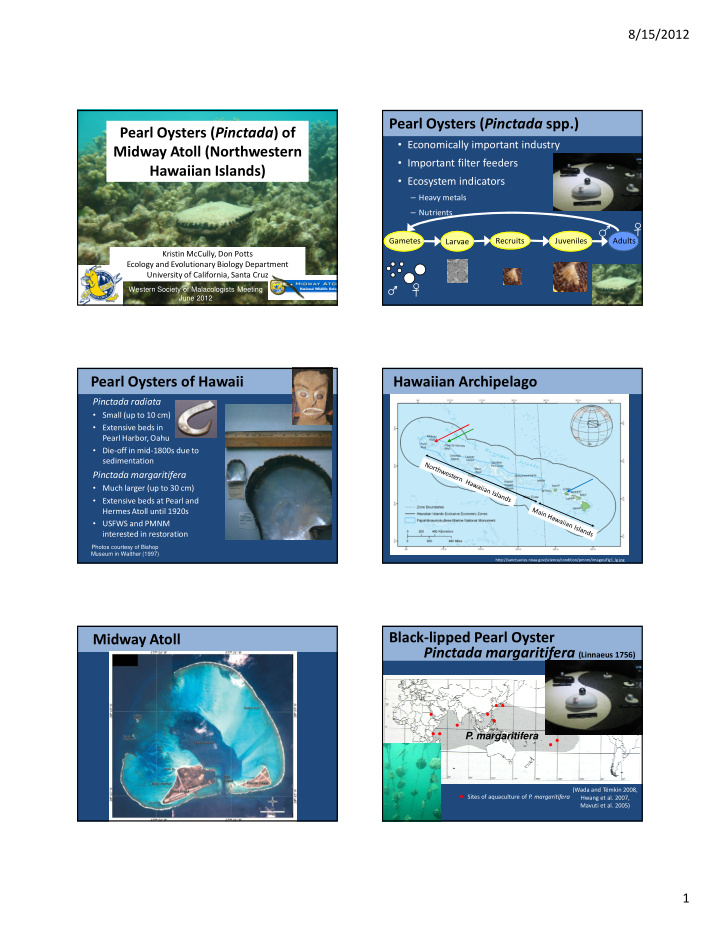



8/15/2012 Pearl Oysters ( Pinctada spp.) Pearl Oysters ( Pinctada ) of • Economically important industry Midway Atoll (Northwestern • Important filter feeders Hawaiian Islands) • Ecosystem indicators – Heavy metals – Nutrients Gametes Recruits Juveniles Adults Larvae Kristin McCully, Don Potts Ecology and Evolutionary Biology Department University of California, Santa Cruz Western Society of Malacologists Meeting June 2012 Pearl Oysters of Hawaii Hawaiian Archipelago Pinctada radiata • Small (up to 10 cm) • Extensive beds in Pearl Harbor, Oahu • Die-off in mid-1800s due to sedimentation Pinctada margaritifera • Much larger (up to 30 cm) • Extensive beds at Pearl and Hermes Atoll until 1920s • USFWS and PMNM interested in restoration Photos courtesy of Bishop Museum in Walther (1997) http://sanctuaries.noaa.gov/science/condition/pmnm/images/fig1_lg.jpg Black-lipped Pearl Oyster Midway Atoll Pinctada margaritifera (Linnaeus 1756) P. margaritifera (Wada and Tëmkin 2008, Sites of aquaculture of P. margaritifera Hwang et al. 2007, Mavuti et al. 2005) 1
8/15/2012 Overall Questions Midway Atoll • What is the current spatial distribution of pearl oysters (and other large bivalves)? • How might managers restore the population? • What are their demographic rates? – Recruitment – Growth – Survival Distribution: Habitats Distribution: Survey Sites Legend 2009 2011 Habitat Backreef Legend Forereef N Patch reef Forereef Sand Backreef NW Patch reef E Deep Sand n = 108 surveys Based on: NOAA. SE SW 2003. Draft atlas of the shallow-water benthic habitats of the NWHI. S Distribution: P. margaritifera Black-lipped pearl oyster Baggy pen shell Pinctada margaritifera Streptopinna saccata 500 m Jewel oyster Cliff oyster Spondylus violacescens Chama iostoma 2
8/15/2012 Distribution: Other Bivalves Restoration? 8 Average Number of Bivalves 7 per 100 sq m (± SE) 6 5 4 3 2 1 0 Spondylus Chama Streptopinna Species Habitat: Fore Back Patch Sand Recruitment: Methods Predation on P. margaritifera • Highest risk of mortality as juveniles Spat • Escape size 80-100 mm collector (Crossland 1957 in Gervis and Sims 1992) • Potential predators (Gervis and Sims 1992) – Fish – Octopus – Predatory gastropods – Sea stars – Crabs Juvenile Growth, Survival, & Predation Juvenile Survival & Predation: Results Site: WB Site: PP 70% Percent Survival for 38 days (±SE) 60% No Mesh Large Mesh No Mesh Large Mesh 50% X 4 tiles X 4 tiles X 4 tiles X 4 tiles 40% X 3 X 3 X 3 X 3 30% juveniles juveniles juveniles juveniles 20% 10% PP 0% WB Open Closed Cage Status 3
8/15/2012 Adult Growth and Survival Molecular Species Identification: Methods • Very hard to identify Pinctada species morphologically (particularly juveniles) • Collected about 100 juveniles at Midway • Variety of coloration, location, 500 m size, dates collected, methods of preservation • Marker: ITS1 between nuclear rDNA genes (Yu and Chu 2006 Biochemical Systematics and Ecology) ITS1 18S 5.8S P. fucata1 Pinctada Phylogeny Phylogeny ML/MP/NJ/BPP P.f. martensi1 P.f. martensi2 0.05 substitutions/site P. fucata2 • Midway samples P. fucata3 P. imbricata – Definitely not P. P. martensi margaritifera P. maculata1 66/66/60/98 – Likely P. P. maculata2 P. maculata3 maculata 18 Midway samples • Working on 85/82/75/73 P. albina1 sequencing P. albina2 P. chemnitzi1 mitochondrial P. chemnitzi2 cytochrome P. nigra P. margaritifera1 oxidase I ( cox1 ) P. margaritifera3 99/99/97/100 P. margaritifera4 marker Photo courtesy of Bishop P. margaritifera2 Museum, Honolulu in P. maxima Cunha et al. (2011) Marine Biotech Walther 1997 Pteria penguin Model: Life Cycle Diagram Model: Goals • To determine most important data to collect in the Hawaiian archipelago • To establish priority life stages and Gametes Recruits Juveniles Adults demographic processes for managers Larvae • To estimate probable impacts of management options, including restoration 4
8/15/2012 Model: Life Cycle Diagram Model: Transition Matrix Male Male FROM Small Juveniles Large 1 2m 2f 3m 3f Adults Adults 1 s 1 (1-g 1 ) 0 f 2 s 0 0 f 3 s 0 2m s 1 g 1 (1-sx 2 ) s 2 (1-g 2 )(1-sx 2 ) 0 0 0 2f s 1 g 1 sx 2 s 2 (1-g 2 )sx 2 s 2 (1-g 2 ) 0 0 TO Female Female 3m 0 s 2 g 2 (1-sx 3 ) 0 s 3 (1-sx 3 ) 0 Small Large Time Step: 3f Adults Adults 0 s 2 g 2 sx 3 s 2 g 2 s 3 sx 3 s 3 1 year Model: Vital Rates Conclusions and Next Steps Description VR • P. margaritifera is very rare at Midway, but is s 0 most common on patch reefs in central lagoon s 1 Probability of survival • Other bivalves are more common on forereef s 2 • Very difficult to restore P. margaritifera , given s 3 g 1 biology and regulatory climate Probability of growth transition g 2 • Next steps: f 2 Fecundity of females – Confirm species identity of recruits f 3 – Use molecular techniques to check species sx 2 Probability of becoming female identity of pearl oysters in Main Hawaiian Islands sx 3 – Further develop and analyze mathematical model Acknowledgments: Funding Acknowledgments: People • Advisor: Don Potts • Mitsubishi Corporation Global Coral Reef • Proposal committee: Conservation Program Laurel Fox • U.S. Fish and Wildlife Service Tim Tinker • Midway Atoll National Wildlife Refuge Maria Haws (UHawaii) • Friends of Long Marine Lab • Statistics help: Pete Raimondi • UCSC Center for the Dynamics and Evolution of the • Labmates: Land-Sea Interface (CDELSI) Wendy Cover, Anne Warner, • DoD National Defense Science and Engineering Helen O’Brien, Rachel Fabian (NDSEG) Fellowship • Lab volunteer: Ryan Harry • UCSC NSF GK-12 grant SCWIBLES 30 5
8/15/2012 Acknowledgments: Midway Team • Field assistants: – Kate Schoenrock – Jamie Barlow • Field volunteers: – Jessica Lee – Mitsubishi volunteers (2008-11) • John Klavitter & Matt Brown (USFWS) 31 6
Recommend
More recommend